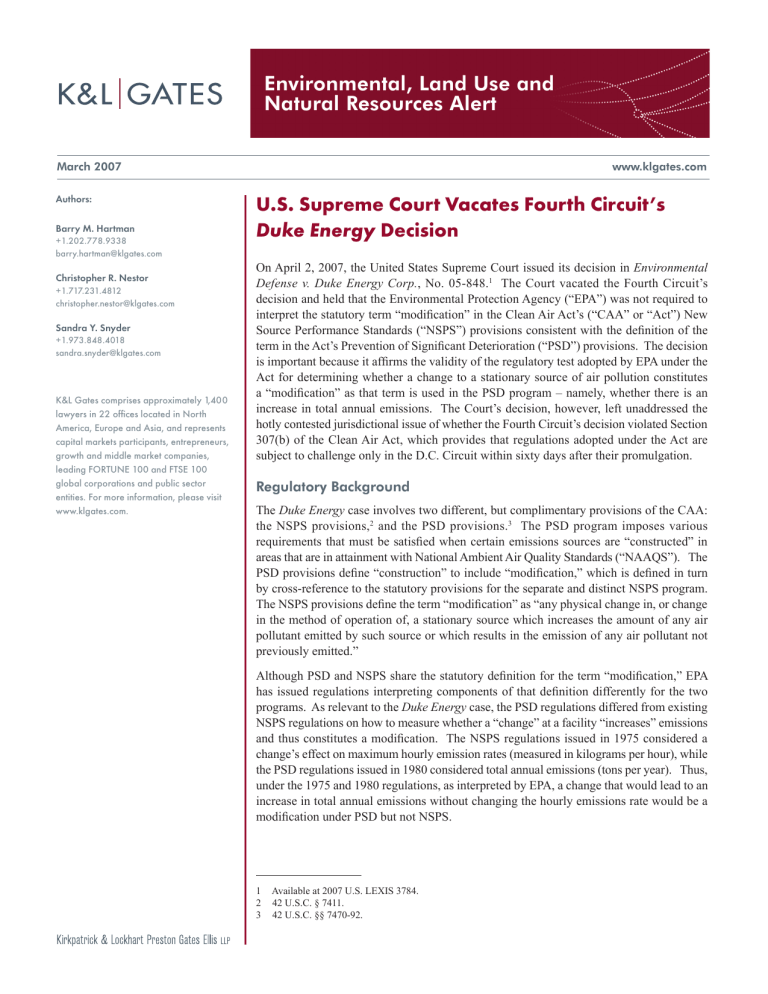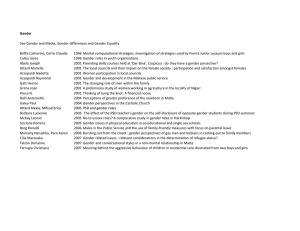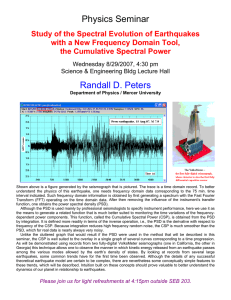Environmental, Land Use and Natural Resources Alert Duke Energy

Environmental, Land Use and
Natural Resources Alert
March 2007
Authors:
Barry M. Hartman
+1.202.778.9338 barry.hartman@klgates.com
Christopher R. Nestor
+1.717.231.4812 christopher.nestor@klgates.com
Sandra Y. Snyder
+1.973.848.4018 sandra.snyder@klgates.com
K&L Gates comprises approximately 1,400 lawyers in 22 offices located in North
America, Europe and Asia, and represents capital markets participants, entrepreneurs, growth and middle market companies, leading FORTUNE 100 and FTSE 100 global corporations and public sector entities. For more information, please visit www.klgates.com. www.klgates.com
U.S. Supreme Court Vacates Fourth Circuit’s
Duke Energy Decision
On April 2, 2007, the United States Supreme Court issued its decision in Environmental
Defense v. Duke Energy Corp.
, No. 05-848.
The Court vacated the Fourth Circuit’s decision and held that the Environmental Protection Agency (“EPA”) was not required to interpret the statutory term “modification” in the Clean Air Act’s (“CAA” or “Act”) New
Source Performance Standards (“NSPS”) provisions consistent with the definition of the term in the Act’s Prevention of Significant Deterioration (“PSD”) provisions. The decision is important because it affirms the validity of the regulatory test adopted by EPA under the
Act for determining whether a change to a stationary source of air pollution constitutes a “modification” as that term is used in the PSD program – namely, whether there is an increase in total annual emissions. The Court’s decision, however, left unaddressed the hotly contested jurisdictional issue of whether the Fourth Circuit’s decision violated Section
307(b) of the Clean Air Act, which provides that regulations adopted under the Act are subject to challenge only in the D.C. Circuit within sixty days after their promulgation.
Regulatory Background
The Duke Energy case involves two different, but complimentary provisions of the CAA: the NSPS provisions, 2 and the PSD provisions.
3 The PSD program imposes various requirements that must be satisfied when certain emissions sources are “constructed” in areas that are in attainment with National Ambient Air Quality Standards (“NAAQS”). The
PSD provisions define “construction” to include “modification,” which is defined in turn by cross-reference to the statutory provisions for the separate and distinct NSPS program.
The NSPS provisions define the term “modification” as “any physical change in, or change in the method of operation of, a stationary source which increases the amount of any air pollutant emitted by such source or which results in the emission of any air pollutant not previously emitted.”
Although PSD and NSPS share the statutory definition for the term “modification,” EPA has issued regulations interpreting components of that definition differently for the two programs. As relevant to the Duke Energy case, the PSD regulations differed from existing
NSPS regulations on how to measure whether a “change” at a facility “increases” emissions and thus constitutes a modification. The NSPS regulations issued in 1975 considered a change’s effect on maximum hourly emission rates (measured in kilograms per hour), while the PSD regulations issued in 1980 considered total annual emissions (tons per year). Thus, under the 1975 and 1980 regulations, as interpreted by EPA, a change that would lead to an increase in total annual emissions without changing the hourly emissions rate would be a modification under PSD but not NSPS.
Available at 2007 U.S. LEXIS 3784.
2 42 U.S.C. § 74.
42 U.S.C. §§ 7470-92.
Environmental, Land Use and
Natural Resouces Alert
The Duke Energy Case
The Duke Energy case arose out of enforcement action taken by EPA against energy provider Duke Energy
Corporation (“Duke”) following Duke’s replacement and repair of corroded boiler tubes. The Attorney
General of the United States filed suit against Duke in
2000 at the request of EPA under the belief that these repairs constituted modifications that triggered the
PSD and New Source Review (“NSR”) requirements of the CAA.
4 EPA believed that before making these repairs, Duke should have engaged in pre-construction review and installed more stringent pollution controls.
According to EPA, failure to do so was a violation of the CAA and PSD rules because Duke’s project increased annual emissions in an area that was in attainment with NAAQS.
5 Duke contended that the boiler repairs did not increase the unit’s hourly capacity to emit pollutants and that the PSD rules provided an exemption for emissions that were due to an increase in the number of hours of operation.
For those reasons,
Duke thought that such repairs were outside the scope of NSR and that EPA’s response signaled a change to EPA’s NSR policy without providing notice to industry.
7
After the Attorney General instituted the action,
Environmental Defense and other environmental groups 8 intervened. The district court ultimately determined that the plain language of the statute required EPA to interpret the PSD term “modification” consistently with the agency’s prior interpretations.
9
Because some earlier EPA determinations stated that a modification would only exist if the project caused an increase in the hourly emissions from the unit, the district court determined that EPA did not have discretion to change its policy later through enforcement action.
0 This decision was affirmed by the United States Court of Appeals for the Fourth
Circuit on the grounds that Congress mandated that the
PSD term “modification” be interpreted consistently
4 United States v. Duke Energy Corp ., 278 F.Supp.2d 619
(M.D.N.C. 200).
5 Id. at 28, 4, 43.
Id. at 40.
7 Id. at 2.
8 In 2001, Environmental Defense, North Carolina Sierra Club, and North Carolina Public Interest Research Group Citizen Lobby/
Education Fund (hereinafter “Environmental Defense”) intervened in the case as plaintiffs at the district court level.
9 Duke, 278 F.Supp.2d at 4-42.
0 Id. at 40.
with its meaning under NSPS.
Therefore, EPA did not have the freedom to interpret the term differently for purposes of PSD.
2
Arguments Before the Court
There were two main issues presented to the Supreme
Court by the Duke Energy case: one was jurisdictional, the other substantive. The jurisdictional issue was whether the Fourth Circuit violated Section 307(b)(2) of the CAA, which provides that EPA’s nationally applicable regulations and standards for implementing the CAA may be reviewed only in the United States
Court of Appeals for the District of Columbia Circuit.
Assuming that the Fourth Circuit’s “interpretation” of the PSD rules did not infringe upon the D.C. Circuit’s exclusive review jurisdiction, the substantive issue was whether Duke’s actions at the various power plants qualified as “major modifications” that triggered review under the CAA’s PSD permitting program and, subsumed therein, whether the CAA requires EPA to interpret the term “modification” consistently in its
PSD and NSPS regulations.
The Jurisdictional Issue
The threshold jurisdictional issue in the Duke Energy case was whether the Fourth Circuit’s decision violated
Section 307(b) of the CAA, which provides that national CAA regulations are subject to challenge
“only” in the D.C. Circuit by petition for review filed within 0 days of their promulgation, and “shall not be subject to judicial review” in enforcement proceedings,
42 U.S.C. § 707(b). The Fourth Circuit held that
Congress’s decision to define “modification” in the
PSD statutory provisions by cross-reference to the
NSPS statutory provisions required EPA to interpret the term consistently in the two programs. The Fourth
Circuit concluded that its statutory analysis was dictated by the Supreme Court’s decision in Rowan
Cos. v. United States , 3 which held that Congress intended substantially identical definitions of the term
“wages” in two different tax statutes to be interpreted to mean the same thing. Recognizing the import of
Section 307(b), the Fourth Circuit reasoned that it was not directly reviewing the PSD rules, but instead was merely mandating that the same interpretation be used
United States v. Duke Energy Corp.
, 411 F.d 59, 546-47 (4th
Cir. 2005).
2 Id.
3 452 U.S. 247 (1981).
March 2007 | 2
Environmental, Land Use and
Natural Resouces Alert for both the PSD and NSPS rules. The Fourth Circuit thus ruled that EPA must “interpret” the definition of “modification” in the PSD rules to require an increase in a unit’s maximum hourly emission rate
- the interpretation that has long been embodied in the
NSPS regulations.
The Substantive Issue
In the Supreme Court, Environmental Defense argued that EPA’s interpretation was appropriate because the PSD rules facially differ from the NSPS rules; therefore, the Fourth Circuit could not require EPA to interpret the term “modification” under PSD to be consistent with the term “modification” under
NSPS. Environmental Defense argued that NSPS was intended to regulate the emissions created from new sources; whereas PSD was enacted to protect areas already in attainment with air quality standards.
Consequently, Environmental Defense argued that the
Fourth Circuit’s decision would provide an exemption for those projects that increase a unit’s operating hours, leading to increased annual pollution, which would conflict with the purposes of the PSD program.
In response, Duke argued that Congress’ intent was clear because the plain language of the 1980 CAA rules states that a major modification triggering PSD will not exist unless there is a modification. To have a modification, Duke contended that there must first be an actual increase in the unit’s hourly emissions rate.
Because the boiler upgrades did not affect the hourly emissions capacity of the unit, Duke’s repairs could not be “modifications” under NSR even though the project enabled the boilers to operate more hours per year.
The Supreme Court’s Decision
The Supreme Court vacated the Fourth Circuit’s decision and remanded the matter for further consideration. The Court held that the Fourth Circuit’s reading of the PSD regulations was an “implicit invalidation” of the regulations, which implicated the restrictions on judicial review stated in Section 307(b) of the Act.
The Court reasoned that principles of statutory interpretation did not mandate that the term
“modification” have the same meaning in the PSD and NSPS provisions. The Court explained that the Fourth Circuit “thought that, by defining the term ‘modification’ identically in its NSPS and
PSD provisions, the Act required EPA to conform its PSD interpretation of that definition to any such interpretation it reasonably adhered to under NSPS.”
The Court rejected the Fourth Circuit’s interpretation, noting that “principles of statutory construction are not so rigid.” Relying upon and interpreting its decisions in Rowan Cos. v. United States , Robinson v. Shell Oil
Co.
, and United States v. Cleveland Indians Baseball
Co.
, 4 the Court noted that “[c]ontext counts,” and that there is no requirement that the same defined term in different provisions of the same statute must
“be interpreted identically.” The Court noted that it made no difference in the statutory construction analysis that the CAA does not merely repeat the same definition in its NSPS and PSD provisions, but that the PSD provisions refer back to the section defining
“modification” for NSPS purposes:
Nothing in the text or the legislative history of the technical amendments that added the crossreference to NSPS suggests that Congress had details of regulatory implementation in mind when it imposed PSD requirements on modified sources; the cross-reference alone is certainly no unambiguous congressional code for eliminating the customary agency discretion to resolve questions about a statutory definition by looking to the surroundings of the defined term, where it occurs.
The Court, implicitly relying on its decision in Chevron
U.S.A., Inc. v. Natural Resources Defense Council , 5 concluded that, absent any “iron rule” to ignore the reasons for regulating PSD and NSPS “modification” differently, EPA’s construction “need do no more than fall within the limits of what is reasonable, as set by the Act’s common definition.”
The Court concluded that the Fourth Circuit’s reasoning that the PSD regulations must conform to their NSPS counterparts was not a permissible reading of their terms. The Court noted that the PSD regulations, while not a “seamless narrative, . . . clearly do not define ‘major modification’ in terms of an increase in the ‘hourly emissions rate.’” On its face, the Court explained, the definition in the PSD regulations specifies no rate at all, hourly or annual, merely requiring a “physical change in or change in the method of operation of a major
4 Rowan Cos. v. United States , 452 U.S. 247 (1981); Robinson v. Shell Oil Co.
, 519 U.S. 7 (1997); United States v. Cleveland
Indians Baseball Co.
, 532 U.S. 200 (200).
5 467 U.S. 87 (1984).
March 2007 |
Environmental, Land Use and
Natural Resouces Alert stationary source that would result in a significant net emissions increase of any” regulated pollutant.
Even when the regulations mention a rate, the Court noted, as in the regulatory definitions of the two terms,
“significant,” and “net emission increase,” the rate “is annual, not hourly.
7 In dismissing the use of an hourly rate as irrelevant, the Court pointed to the mandate that
“actual emissions shall be calculated using the unit’s actual operating hours.” 8 Since “actual emissions” must be measured in a manner looking to the number of hours the unit is or probably will be actually running, the Court reasoned that the rate of operation is not pertinent. Noting that the Fourth Circuit’s reasons for its different view “are no match for these textual differences,” the Court concluded that:
. . . we have to see the Court of Appeals’s construction of the 1980 PSD regulations as an implicit invalidation of those regulations, a form of judicial review implicating the provisions of
§ 307(b) of the Act, which limit challenges to the validity of a regulation during enforcement proceedings when such review “could have been obtained” in the Court of Appeals for the
District of Columbia within 60 days of EPA rulemaking.
Interestingly, however, the Court avoided directly addressing the jurisdictional issue raised by the parties, noting that “because the Court of Appeals did not believe that its analysis reached validity, it did not consider the applicability or effect of [Section 307(b) of the CAA]” and, consequently, the Court had “no occasion at this point to consider the significance of §
307(b) ourselves.”
Implications of the Decision
The immediate significance of the Duke Energy decision is its rejection of the interpretation accepted by the Fourth Circuit that would have allowed changes to be made to emission sources without PSD review provided that the changes did not increase a unit’s maximum hourly emission rate. Instead, the decision validates the regulatory test adopted by the EPA for determining whether a change to a stationary source of air pollution constitutes a “modification” requiring
PSD review – namely, whether there is an increase in total annual emissions. The decision has the potential
40 C.F.R. § 51.166(b)(2)(i).
7 See , e.g., § 5.(b)(23)(i).
8 40 C.F.R. § 51.166(b)(21)(ii).
to increase the length and expense of permitting and to require retrofitting with improved technology at facilities that are undertaking (or have undertaken)
“modifications” that trigger PSD review. The decision also likely will shift the focus of future litigation involving EPA’s NSR enforcement initiative to issues such as the application of the “routine maintenance, repair and replacement” exclusion from the NSR program, an issue that was not considered by the
Fourth Circuit and was not before the Supreme Court in the Duke Energy case.
It should also be noted that on October 20, 2005,
EPA, partially in response to the Fourth Circuit’s
Duke Energy decision, published proposed changes to its NSR permitting program to provide nationwide consistency in how states implement the program for electric generating units. The proposed changes would standardize the emissions tests used in NSR to determine if a physical or operational change at a power plant would cause emission increases that would require the plant to install additional pollution controls.
19 While EPA “disagreed” with the Fourth
Circuit’s Duke Energy decision, and noted “differences” between NSPS and PSD precluding an identical modification test for both, the agency considered the need for changes made “apparent” by the Fourth
Circuit’s ruling.
20 The success of the United States and
Environmental Defense in the Duke Energy case may cause EPA to revisit this proposed rulemaking.
In addition, although the Court did not directly address the issue, the Duke Energy decision suggests that the
Court is sensitive to the limitations imposed by Section
307(b) of the CAA on judicial review of regulations promulgated under the CAA. The language of the
Court’s decision suggests that it may be inclined to hold that lower courts are precluded, in the context of an enforcement action, from adjudicating the merits of defenses constituting judicial review of the CAA regulations themselves. Consequently, the regulated community needs to be cognizant of the limitations imposed by Section 307(b) of the CAA and the fact that opportunities for post-enforcement review of CAA regulations may be limited or barred.
19 See 70 Fed. Reg. 61081 (Oct. 20, 2005).
20 Id. at 08, 083 & n.3.
March 2007 |
Environmental, Land Use and
Natural Resouces Alert
K&L Gates comprises multiple affiliated partnerships: a limited liability partnership with the full name Kirkpatrick & Lockhart Preston Gates Ellis LLP qualified in
Delaware and maintaining offices throughout the U.S., in Berlin, and in Beijing (Kirkpatrick & Lockhart Preston Gates Ellis LLP Beijing Representative Office); a limited liability partnership (also named Kirkpatrick & Lockhart Preston Gates Ellis LLP) incorporated in England and maintaining our London office; a Taiwan general partnership (Kirkpatrick & Lockhart Preston Gates Ellis) which practices from our Taipei office; and a Hong Kong general partnership (Kirkpatrick &
Lockhart Preston Gates Ellis, Solicitors) which practices from our Hong Kong office. K&L Gates maintains appropriate registrations in the jurisdictions in which its offices are located. A list of the partners in each entity is available for inspection at any K&L Gates office.
This publication/newsletter is for informational purposes and does not contain or convey legal advice. The information herein should not be used or relied upon in regard to any particular facts or circumstances without first consulting a lawyer.
Data Protection Act 1998—We may contact you from time to time with information on Kirkpatrick & Lockhart Preston Gates Ellis LLP seminars and with our regular newsletters, which may be of interest to you. We will not provide your details to any third parties. Please e-mail london@klgates.com
if you would prefer not to receive this information.
©1996-2007 Kirkpatrick & Lockhart Preston Gates Ellis LLP. All Rights Reserved.
March 2007 |





